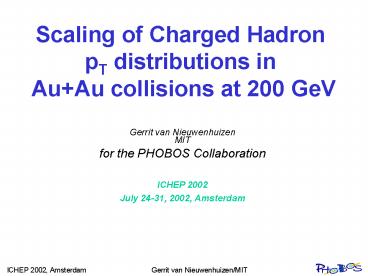Counting on QCD PowerPoint PPT Presentation
Title: Counting on QCD
1
Scaling of Charged Hadron pT distributions in
AuAu collisions at 200 GeV
Gerrit van Nieuwenhuizen MIT for the PHOBOS
Collaboration ICHEP 2002 July 24-31, 2002,
Amsterdam
2
Collaboration
ARGONNE NATIONAL LABORATORY Birger Back, Alan
Wuosmaa BROOKHAVEN NATIONAL LABORATORY Mark
Baker, Donald Barton, Alan Carroll, Nigel George,
Stephen Gushue, George Heintzelman, Burt
Holzman, Robert Pak, Louis Remsberg, Peter
Steinberg, Andrei Sukhanov INSTITUTE OF NUCLEAR
PHYSICS, KRAKOW Andrzej Budzanowski, Roman
Holynski, Jerzy Michalowski, Andrzej Olszewski,
Pawel Sawicki, Marek Stodulski, Adam Trzupek,
Barbara Wosiek, Krzysztof Wozniak MASSACHUSETTS
INSTITUTE OF TECHNOLOGY Maartin Ballintijn, Wit
Busza (Spokesperson), Patrick Decowski, Kristjan
Gulbrandsen, Conor Henderson, Jay Kane, Judith
Katzy, Piotr Kulinich, Jang Woo Lee, Heinz
Pernegger, Corey Reed, Christof Roland, Gunther
Roland, Leslie Rosenberg, Pradeep Sarin,
Stephen Steadman, George Stephans, Carla
Vale, Gerrit van Nieuwenhuizen, Gábor Veres,
Robin Verdier, Bernard Wadsworth, Bolek
Wyslouch NATIONAL CENTRAL UNIVERSITY,
TAIWAN Chia Ming Kuo, Willis Lin, Jaw-Luen
Tang UNIVERSITY OF ILLINOIS AT CHICAGO Russell
Betts, Edmundo Garcia, Clive Halliwell, David
Hofman, Richard Hollis, Aneta Iordanova, Wojtek
Kucewicz, Don McLeod, Rachid Nouicer, Michael
Reuter, Joe Sagerer UNIVERSITY OF
MARYLAND Abigail Bickley, Richard Bindel, Alice
Mignerey, Marguerite Belt Tonjes UNIVERSITY
OF ROCHESTER Joshua Hamblen, Erik Johnson, Nazim
Khan, Steven Manly, Inkyu Park, Wojtek
Skulski, Ray Teng, Frank Wolfs
3
The PHOBOS Apparatus
- Trigger Centrality
- Paddle Counters
- ZDCs
137000 Si Pad Channels
- 1 Layer 4p Multiplicity Array
- Octagonal Barrel Annular Rings
- 16 Layer 2-Arm Spectrometer
4
The PHOBOS Spectrometer
10cm
- Outer layers situated in 2T magnetic field
- High segmentation in bending direction
- Tracking within 10 cm of interaction point
- Coverage near mid-rapidity
- Phi acceptance of 3 per Arm
70 cm
z
x
y
5
PHOBOS-Spectra _at_ 200GeV
- Spectra corrected for
- Acceptance/Efficiency
- Ghost Tracks
- Momentum resolution
- Variable bin width
- Secondaries
- At 200 GeV min. bias. pp reference data exists
_
0.2ltyp lt1.4
6
Comparing AuAu and pp Spectra 1
_
- Production of high pT particles dominated by hard
scattering - High pT yield prop. to Ncoll
- (binary collision scaling)
- Compare to pp spectra scaled up by Ncoll
- Violation of Ncoll scaling observed at 130GeV
- (PHENIX/STAR publications)
- Jet quenching?
AuAu
_
7
Charged Particle Production
Total Multiplicity
Preliminary
from Peter Steinbergs talk
- Total multiplicity scales with Npart
8
Comparing AuAu and pp Spectra 2
_
9
Scaled Spectra / pp-Fit
_
PHOBOS Preliminary
Centrality Npart
45-50 65 4
35-45 93 5
25-35 138 6
15-25 200 8
6-15 276 9
0-6 344 12
- Centrality range
- ltbgt from 10 to 3 fm
- ltngt from 3 to 6
10
Scaled Spectra / pp-Fit
_
PHOBOS Preliminary
- Shape differs from pp already at Npart 65
- Moderate change from Npart 65 to Npart 344
_
11
Centrality scaling in pT bins
Relative Yield
Npart
Spectra normalized to yield at Npart 65
12
Npart Scaling at high pT
PHOBOS Preliminary
Ncoll-scaling
Normalized to yield at Npart 65
- Npart scaling describes data at pT 4.25 GeV/c
13
Evolution with Centrality
PHOBOS
- Follow change of shape vs most peripheral bin
- Dominantly participant scaling
- Violated by about 30 for most central collisions
14
Summary
- Measured h,- pT spectra in 200 GeV AuAu
collisions - pT range 0.2 lt pT lt 5 GeV/c
- Rapidity range 0.2 lt yp lt 1.4
- Centrality range 65 lt Npart lt 344
- Data show
- Substantial difference in spectral shape between
pp and peripheral AuAu (Npart 65) - Minor change from 65 to 344 participants
- Even at pT of 4 5 GeV/c, Npart -scaling from
peripheral to central AuAu
_
15
The End
16
Comparison to Lower Energies
- Data taken at 130GeV shows similar trends
- Shape is consistent with measurements by STAR
Relative Yield
17
How to compare spectra to pp?
_
- Observations
- Mid-rapidity multiplicity compatible with two
component model - Total multiplicity shows Npart scaling
- How do spectra scale with centrality?
- Does scaling change over the pT range?
- Crucial for physics interpretation
18
Charged Particle Production
Central Density
200 GeV
AuAu
n Ncoll/(Npart/2)
130 GeV
19.6 GeV preliminary
Data from PRC 65 061901R (2002)
Two Component Model
19
Number of collisions at different Energies
20
Integrated Yields vs Centrality
dN/dy Spectra Integral
dN/dh - Multiplicity data
21
Mean pT vs centrality
22
Centrality scaling in pT bins
Relative Yield
Npart
Spectra normalized to FIT to yield at Npart 65
23
Corrections
Ghost fraction
pT GeV/c
pT GeV/c
pT GeV/c
24
Systematic Errors
25
Triggering on Interactions
Positive Paddles
Negative Paddles
ZDC N
ZDC P
Au
Au
PN
PP
- Coincidence between
- Paddle counters
- Paddle ZDC timing reject background
Valid Collision
26
Centrality Determination
Data
HIJING GEANT Glauber calculation Model of
paddle trigger
Paddle signal
DataMC
Nparticipants
27
Particle Tracking In Spectrometer
- Road-following algorithm finds straight tracks in
field-free region - The curved tracks in B-field found by clusters in
(1/p, ?) space - Find match of straight and curved by ?,
consistency in dE/dx and fit in yz-plane - Covariance matrix track fit for momentum
reconstruction and ghost rejection
z
By
Beam
2
1
x
10 cm
28
Spectrometer Performance
Acceptance
Momentum Resolution
- Data Sample Production Run 2001(200 GeV)
- 7.8 M AuAu Events, Min. Bias Trigger
- 32 M reconstructed particles

